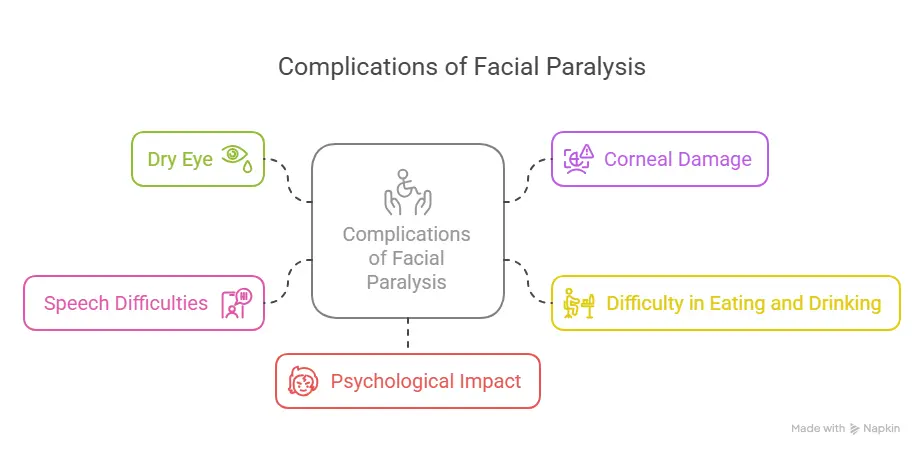Definition
Facial palsy is a neurological disorder characterized by the sudden onset of weakness or paralysis of the facial muscles on one side, leading to drooping, asymmetry, and an inability to control facial expressions.
Causes
condition can arise from various etiologies, with the most common being idiopathic, often referred to as Bell’s palsy. Other causes include infections, trauma, and direct damage to the facial nerve.
CLINICAL EVALUATION AND DIAGNOSIS
- Clinical evaluation is key for facial nerve palsy diagnosis.
- Distinguishing between peripheral and central lesions is crucial.
- MRI aids in ruling out structural disorders and detecting inflammation.
- Awareness of specific facial weakness patterns guides appropriate assessment.
COMPLICATIONS

PATHOPHYSIOLOGY OF FACIAL PALSY
Facial nerve (cranial nerve VII) controls facial muscles, and palsy can result from diverse causes:
- Bell’s Palsy: Often linked to herpes simplex virus reactivation, though exact mechanism is unclear.
- Trauma: Fractures, especially involving the temporal bone, can damage or sever the facial nerve.
- Infections: Herpes zoster oticus and various infections like middle ear infections, mastoid infections, and Lyme disease can lead to facial palsy.
- Other Causes: Sarcoidosis, tumors, diabetes, chronic meningitis, and nerve invasion by carcinomas or leukemias can also result in facial palsy.
EPIDEMIOLOGY
- Facial palsy affects around 3-1 per 100,000 globally, with higher incidence among children and adults over 60.
- Bell’s palsy is the primary cause, with other contributors including stroke, infections, trauma, tumors, neurological disorders, and congenital factors.
- In the GCC and Middle East, prevalence is approximately 0.5%, comparable to the global rate.
- Symptoms range from facial weakness to hearing problems, impacting daily life and causing social and emotional challenges.
- In the Middle East and GCC, facial palsy is a significant cause of disability, affecting about 1 million individuals.
INTEGRATION OF TISSUE ENGINEERING IN FACIAL PALSY MANAGEMENT
- Immediate Post-Injury (0-72 hours): Apply nerve growth factor and bioactive scaffolds to support immediate facial nerve repair and regeneration, reducing inflammation.
- Early Post-Injury (72 hours to 3 weeks): Utilize advanced cell therapy like Schwann cell transplantation or stem cells to enhance natural regeneration and promote muscle reinnervation.
- Intermediate Stage (3 weeks to 3 months): Combine electrical stimulation therapy with bioengineered scaffolds to facilitate nerve growth and prevent muscle atrophy.
- Late Post-Injury (3 months onwards): Introduce long-term regenerative scaffolds with growth factors and, in severe cases, tissue-engineered muscle grafts for comprehensive facial nerve regeneration.
- Long-Term Management (Months to years): Employ personalized tissue-engineered constructs and microsurgical interventions for reconstructive purposes, addressing residual deficits and asymmetry, especially when conventional therapy is insufficient.
Case Studies (Before&After)



